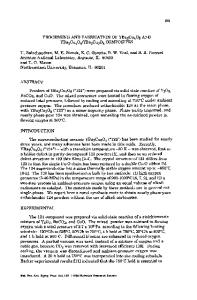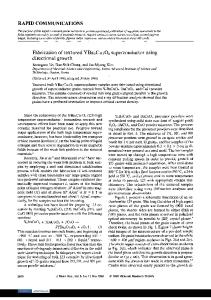Compressive creep of YBa 2 Cu 3 O x
- PDF / 1,263,974 Bytes
- 5 Pages / 593.28 x 841.68 pts Page_size
- 47 Downloads / 392 Views
A. R. de Arellano-Lopez and A. Dominguez-Rodriguez Universidad de Sevilla, 41080 Sevilla, Spain
(Received 21 June 1990; accepted 24 August 1990) YBa2Cu3Ox was deformed from 850 to 980 °C in oxygen partial pressures of 103 to 105 Pa. Steady-state creep rate, e, for P(O2) from 104 to 105 Pa could be expressed as e = Aayo (GS)"28±06 exp -(970 ± 130 kJ/mole)/R7; where A is a constant, a-the steady-state stress, GS the average grain size, and R and T have their usual meanings. For P(O2) from 103 to 3 x 103 Pa, the activation energy decreased to about 650 kJ/mole and for a given temperature creep kinetics were much faster. The data and microscopic observations indicated that creep occurred by diffusional flow. Comparisons with diffusion data for YBa2Cu3O;E suggested that Y or Ba may be rate-controlling diffusing species.
I. INTRODUCTION
High-temperature deformation has been used to produce dense, textured bulk YBa2Cu3Ox.15 Deformation can alter defect structures and, consequently, superconducting properties.6'7 Studies of deformation also yield information on diffusional processes.8'9 Since these processes govern sintering and grain growth, information from deformation can be used to devise optimum sintering schedules. In fact, studies of YBa2Cu3O* indicated that low oxygen pressures accelerated deformation rates.9 This result was confirmed in sintering studies,10 and low oxygen pressures are now often used in sintering YBa2Cu3O^. In a previous study, we reported that for temperatures from 850 to 980 °C and oxygen partial pressures, P(O2), from about 104 to 105 Pa, data for high-temperature deformation of YBa2Cu3O^ could be fit to: e = y4'o-10P(O2)-°-48±006 exp-(800 ± 100 kJ/RJ), (1) where e is strain rate, A' a constant, a the steady-state stress, and R and T have their usual meanings.9 Deformation by diffusional flow and faster kinetics for lower P(O2) were confirmed, but several questions remained. First, the specimens were made from powder of only fair phase purity911 and impurity effects may have been possible. Second, no attempt was made to relate deformation to grain size. [Diffusional flow rates will generally be inversely proportional to grain size, GS, squared or cubed, that is, e .
(a)
(b)
FIG. 2. Optical micrographs of YBa2Cu3Ojr specimens (a) as-sintered and (b) crept in pure oxygen (bars equal 20 jitm).
Creep data for nonstoichiometric oxides are often analyzed for the effect of P{O2) on steady-state strain rate16-26-27: The exponent m can be related to the rate-controlling diffusing species.26 As shown in Fig. 3, deformation kinetics increase as P(O2) decreases. (If the data presented in Fig. 3 were normalized to the same stress the differences between strain rates for any temperature at 103 and 104 Pa would increase.) No functional dependence was calculated, however, because of the change in Q in the range of P(O2) tested; neither the high-Q nor low-Q ranges of P(O2) were large enough to allow for accurate determination of a P(O2) exponent. The origin of the lower Q and more rapid kinetics for low
Data Loading...











